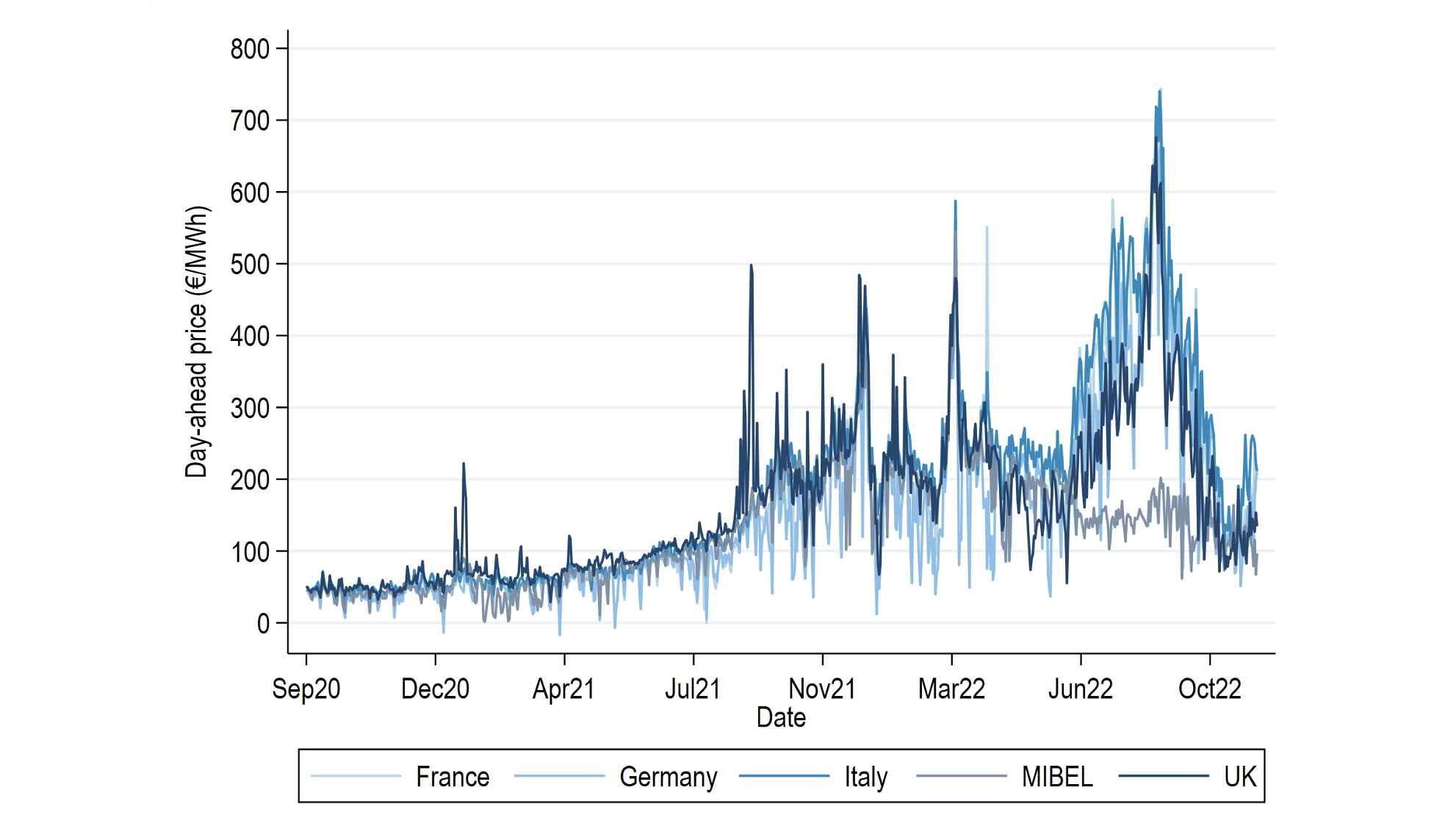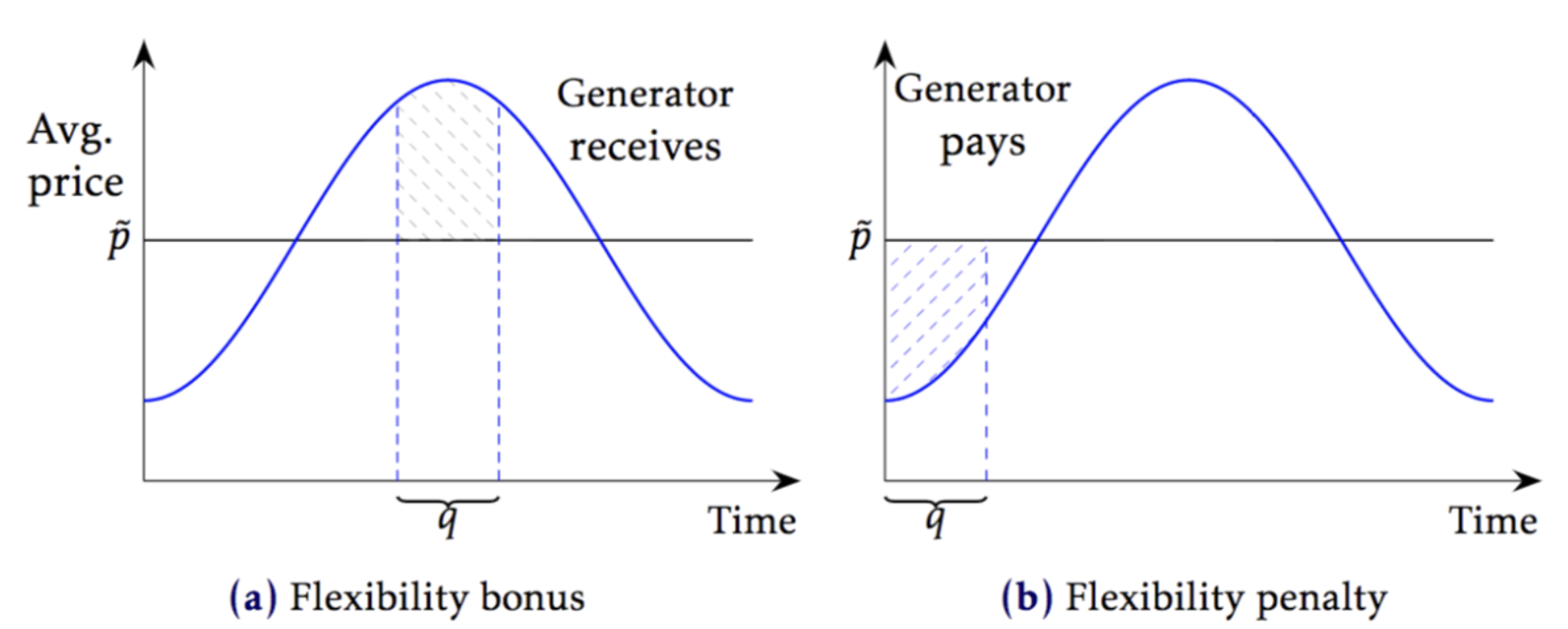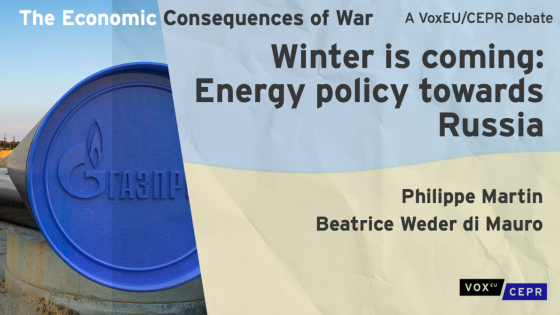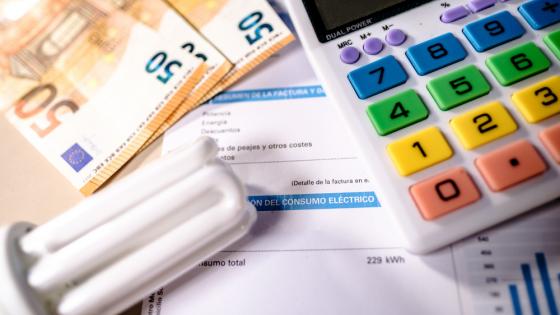“The current electricity market design is not doing justice to consumers anymore. They should reap the benefits of low-cost renewables. So, we have to decouple the dominant influence of gas on the price of electricity. This is why we will do a deep and comprehensive reform of the electricity market.” These words were pronounced by the President of the European Commission in her State of the European Union speech in September 2022 (von der Leyen 2022). By then, gas and electricity prices had reached record highs (Figure 1), with growing concerns about gas shortages during winter (Martin and Weder di Mauro 2022). The rise in energy costs contributed to double-digit inflation in the euro area (Eurostat 2022), leading to the highest-ever increase in interest rates by the ECB (Dieppe and Brignone 2022).
Four months later, the European Commission is about to open a public consultation on the electricity market reform they are working on (European Commission 2022). In this column, I shed light on what I think should be the building blocks of this reform. The interested reader can find the full details of the proposed electricity market architecture in Fabra (2022).
Figure 1 Electricity prices in European wholesale electricity markets
Source: Red Eléctrica de España.
Objectives and building blocks of the new market architecture
The reform should lead to efficient and equitable electricity market outcomes. In the short run, achieving productive efficiency requires that demand is met, at every moment in time, by the plants with the lowest marginal costs. In the long run, investments should efficiently take place at the right scale and locations. In particular, investments in low-carbon technologies should be promoted to meet future electricity needs without compromising security of supply. For equity, households and businesses should fully benefit from the lower costs of these technologies, which further helps promote electrification to decarbonize hard-to-abate emissions in other sectors.
Figure 2 The proposed market architecture
These objectives can be reconciled by combining short-run energy markets, which provide short-run signals for efficient generation and consumption, with long-term contracts, which facilitate efficient investments in generation while adjusting their profitability through competitive forces (Figure 2). These two pillars of the proposed electricity market architecture complement each other and interact in several ways:
1) A well-functioning short-term market
Electricity demand and supply change at high frequency. Hence, productive efficiency must rely on electricity markets that clear close to real time, very similar to those operating today in Europe. However, certain design elements can be put forward to improve their performance. Importantly, compulsory participation in these markets (as in the original UK market design) would contribute to greater liquidity and transparency without preventing the market participants from entering into financial contracts with third parties. Long-term contracts, as described below, would further prevent the short-run price signal from being distorted by market power (Fabra and Imelda 2022).
2) Efficient and equitable long-term contracts for all consumers
Electricity generation assets are highly capital-intensive and long-lived, often giving rise to various positive and negative externalities (e.g. affecting learning economies, security of supply, or the environment, to name just a few). This suggests that achieving long-term efficiency requires some form of long-term contracting, with the regulator playing an active role in deciding the scale and technologies of the investments. Furthermore, for outcomes to be equitable, regulators must resort to mechanisms allowing electricity prices to reflect the average costs of the investments in ways compatible with facing firms and consumers to short-run prices. In my view, adequate long-term contracting is missing from current electricity markets, and addressing this should be the focus of our efforts. How exactly should long-run contracts be incorporated into the market architecture?
Designing long-term contracts
In line with other economists (see Newbery 2022, Roques and Finon 2002, and Kröger et al. 2022, among others), I advocate for developing a system of long-term contracts between the regulator and the generators. Reliance on long-term contracts allows de-risking the investments, effectively allowing for an efficient transfer of risk – from the more risk-averse side (i.e. the private investors) to the less risk-averse side (i.e. the regulator on behalf of all consumers). This approach facilitates generators’ access to cheaper capital, opening the market to competitors that would otherwise not be able to finance the investments. Competition for these contracts through auctions organised by the regulator would pass on this efficiency gain to consumers, who would also be hedged against excessive price volatility.
The design of long-term contracts should differ across technologies depending on their flexibility to respond to short-run price signals. These contracts can be designed so as to enhance firms' efficient behaviour in the short-term market. For instance, preserving full-price exposure is paramount for the efficient operation of storable resources, including hydropower, which should be used when they are most valuable. In contrast, exposing wind or solar plants to short-run prices brings limited benefits, given that their output is intermittent and exogenously given by weather conditions.
An important economic principle should be kept in mind throughout: exposing producers to short-run price signals is compatible with decoupling their average payments from those prices.
To see this, consider the design of contracts-for-differences (CfDs). Under these contracts, producers sell their output in the short-term market and then pay/receive the difference between a ‘reference price’ and the contract’s strike price. Setting the ‘reference price’ equal to the short-term price is equivalent to a fixed price contract with no price exposure and no price risk. Departing from this allows for striking the right balance between the benefits of price exposure and the costs of increasing investors’ risks – a trade-off that depends on the technologies’ characteristics.
For instance, for hydropower plants, setting the ‘reference price’ at the annual average market price effectively provides a bonus for producing at peak times or a penalty for producing at off-peak times (Figure 3). For intermittent renewables, setting the ‘reference price’ at the monthly average price captured by plants of the same technology incentivises them to locate at sites where the availability of solar irradiation or wind is positively correlated with market prices, contributing to reducing the system’s costs. In both cases, marginal incentives are preserved while their profitability is adjusted through the choice of the strike price. Setting the strike price through auctions before the investments have been made contributes to achieving cost-reflective electricity prices.
Figure 3 Flexibility bonus/penalty implicit in the contracts for differences for hydropower plants
However, sufficient participation in the auction is needed for competitive forces to deliver a fair rate of return. Incentivising firms to participate in the auction requires that the outside option of selling directly to the short-term market is not feasible or not too attractive. Once renewables are massively deployed, the short-term market prices captured by renewables will converge towards their (almost zero) marginal costs, i.e. below their average costs. Hence, entry outside the auction will not be attractive even if feasible. Until then, participation in the auction could be promoted by limiting (to a reasonable level) the maximum price that renewables can obtain in short-term markets – not just as a crisis instrument, but as a permanent market feature. Since renewables have low marginal costs, such a cap would not distort their efficient operation.
For existing plants, competition to enter the market is simply not possible. Two options to guarantee equitable outcomes are to introduce technology-specific caps or to regulate their strike prices in a cost-reflective manner. No doubt, this will require political will. However, the economic, social, and political costs of not addressing the large windfalls made by these plants are not less challenging.
Last, the characteristics of gas plants, storage, and demand response facilities suggest they should be fully exposed to short-term market prices. Yet, to overcome their missing money problem (Joskow 2008) – in essence, short-term market prices do not allow them to recover their investment costs – they should receive capacity payments – not necessarily technology-neutral as they are nowadays (Fabra and Montero 2022). In the case of gas plants, capacity payments should be combined with commodity-indexed price caps (the so-called reliability options) to prevent them from exercising market power when they are pivotal.
Contracting with the regulator, or bilaterally?
One recurring question in the debate is whether regulators should be the counterparty of the long-term contracts or whether such contracts should be freely signed bilaterally between generators and retailers (so-called power purchase arrangements, or PPAs), with no public intervention. My view is that the latter are not substitutes for the former. We have seen this already: nothing prevents PPAs from being signed, yet several market failures have led to scarce and excessively short PPA contracting (May et al. 2022). Furthermore, even if large energy retailers manage to secure low wholesale prices through PPAs, imperfect competition in the retail market often implies that such prices are not passed on to the final consumers. In contrast, regulators can commit for sufficiently long periods compatible with the recovery of the investments. This would substantially reduce counterparty risk, which is instrumental in lowering the costs of procuring renewable energy (Ryan 202). Furthermore, a system of regulator-backed long-term contracts would guarantee that all consumers – regardless of their bargaining powers – would benefit equally from the reduced counterparty risk and the enhanced bargaining power of the regulator acting as a large buyer.
Last, even if desirable, increasing the liquidity of forward markets is not a substitute for these regulator-backed long-term contracts either. The prices of forward contracts tend to converge to the expected short-term market prices over the same period, thus reducing price volatility but not the price level.
Conclusions
Europe must take advantage of this opportunity to redesign an outdated electricity market design, which now threatens the region's economic, social, and environmental objectives. Changing the electricity market design without significantly affecting the outcomes would be a lost opportunity. The risk of "plus ça change, plus c’est la même chose" is not negligible. In my proposal, I argue that it is feasible to redesign electricity markets to make them more robust to future crises while simultaneously achieving carbon abatement goals at least cost for consumers and society. Power markets can be a powerful source of welfare for the whole economy, just as long as we design them right.
References
Dieppe, A and D Brignone (2022), “Synchronised interest rate hikes, spillovers and risks to global growth”, VoxEU.org, 14 November.
European Commission (2022), "Policy Options to Mitigate the Impact of Natural Gas Prices on Electricity Bills", Non-Paper.
Eurostat (2022), Harmonised index of consumer prices (HICP).
Fabra, N (2022), "Electricity Markets in Transition: A proposal for reforming European electricity markets", EEL Discussion Paper 115.
Fabra, N and Imelda (2022), "Market Power and Price Exposure: Learning from Changes in Renewables Regulation", CEPR Discussion Paper 17689 (forthcoming in American Economic Journal: Economic Policy).
Fabra, N and J P Montero (2022), "Technology-neutral versus Technology-specific Procurement", CEPR Discussion Paper 15554 (forthcoming in Economic Journal).
Joskow, P L (2008), "Capacity payments in imperfect electricity markets: Need and design", Utilities Policy 16(3): 159-170.
Kröger, M, K Neuhoff, and J C Richstein (2022), "Contracts for difference support the expansion of renewable energy sources while reducing electricity price risks", DIW Weekly Report 12.35/36, 205-213.
Martin, P and B Weder di Mauro (2022), "Winter is coming: Energy policy towards Russia", VoxEU.org, 23 July.
May, N, K Neuhoff and J C Richstein (2022), "Financing renewables in the age of falling technology costs", Resource and Energy Economics 70.
Newbery, D (2021), "Designing an incentive-compatible efficient Renewable Electricity Support Scheme", CWPE2128.
Roques, F and D Finon (2017), "Adapting electricity markets to decarbonisation and security of supply objectives: Toward a hybrid regime?", Energy Policy 105.
Ryan, N (2021), "Holding Up Green Energy", NBER Working Paper 29154.
von der Leyen, U (2022), "2022 State of the Union Address".






